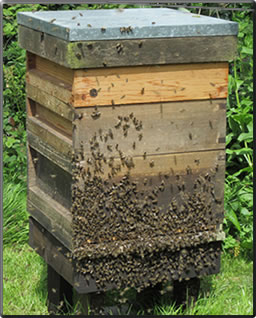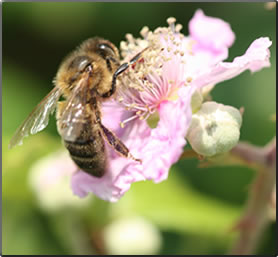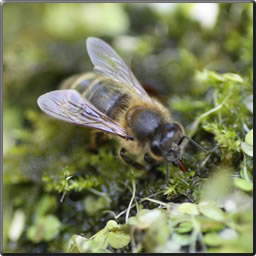Hive requirements
Seasons
The bees forage for four essentials required by the colony: pollen, nectar, water, and propolis.

water
is needed in the hive mainly in winter and springtime when the colony is expanding to dilute stored honey and for the use by nurse bees to produce the jelly for feeding the larva. In summer water is used to thermoregulate the hive on hot days by evaporative cooling.
The water gathering bees shown left use a favourite stone covered in moist moss to take up water from our pond close to the apiary.
is needed in the hive mainly in winter and springtime when the colony is expanding to dilute stored honey and for the use by nurse bees to produce the jelly for feeding the larva. In summer water is used to thermoregulate the hive on hot days by evaporative cooling.
The water gathering bees shown left use a favourite stone covered in moist moss to take up water from our pond close to the apiary.

black bee on bramble
propolis
is collected from plant buds and brought back to the hive on the bees' back legs like pollen. The bees use propolis to block up any crack or small hole in the hive and to strengthen the comb. Propolis has strong anti-fungal and antibacterial properties. All surfaces on the inside of the hive are varnished by the bees with propolis.
In this apiary it is not a nuisance but in a colony left in Cork City for a season, a dark red propolis covered everything. On returning to the home apiary propolis ceased to be a problem. The conclusion drawn was that it is probably the local plants rather than the bee which caused the problem.
 black bee taking in water through moss
black bee taking in water through moss black bee with luminescent orange "pollen" from an unknown source
black bee with luminescent orange "pollen" from an unknown sourcenow thought to be from
Poplar leaf rust fungus
nectar
From the beginning of April to the end of August a colony will collect between 200 lb.. and 300 lb. of nectar - and sometimes much more. The bees use the enzyme invertase to convert the sucrose in the nectar to glucose and fructose. Essentially the nectar is used in 3 ways:
1. through respiration the sugars are burnt to provide the energy which drives the daily activity of the bees. Heat is a by-product of this chemical reaction.
2. nectar and pollen are mixed to produce the food for the grubs.
3. excess nectar is stored as honey either around the brood in readiness to be fed to the grubs or over the brood nest in the supers.
The temperature of the brood nest is maintained at a constant 35 °C during the day and night. The heat required for maintaining this temperature is produced by the bees themselves through respiration, but heat is also given out by the developing brood.
From the beginning of April to the end of August a colony will collect between 200 lb.. and 300 lb. of nectar - and sometimes much more. The bees use the enzyme invertase to convert the sucrose in the nectar to glucose and fructose. Essentially the nectar is used in 3 ways:
1. through respiration the sugars are burnt to provide the energy which drives the daily activity of the bees. Heat is a by-product of this chemical reaction.
2. nectar and pollen are mixed to produce the food for the grubs.
3. excess nectar is stored as honey either around the brood in readiness to be fed to the grubs or over the brood nest in the supers.
The temperature of the brood nest is maintained at a constant 35 °C during the day and night. The heat required for maintaining this temperature is produced by the bees themselves through respiration, but heat is also given out by the developing brood.
pollen
Pollen provides the bees with fats, proteins and trace elements. Over 100 lb. of pollen is collected by a colony over the season. Pollen is one of the most nutritious food known.
In the hive the bees store enough pollen to last 2 to 3 weeks in case of emergency. It is eaten and together with nectar provides the food fed by the nurse bees to the queen and grubs.
In autumn in preparation for winter the worker bee digests large quantities of pollen. This increases the amount of biopterin in the larval food which results in the black bee being able to store fats and protein. (click for more info) And so bring the hypopharyngeal gland of the winter bee into nurse bee condition ready for brood rearing in the spring.
For a comprehensive account of pollen its composition and uses see for example.
In the hive the bees store enough pollen to last 2 to 3 weeks in case of emergency. It is eaten and together with nectar provides the food fed by the nurse bees to the queen and grubs.
In autumn in preparation for winter the worker bee digests large quantities of pollen. This increases the amount of biopterin in the larval food which results in the black bee being able to store fats and protein. (click for more info) And so bring the hypopharyngeal gland of the winter bee into nurse bee condition ready for brood rearing in the spring.
For a comprehensive account of pollen its composition and uses see for example.
Foraging Range
The black bee has a foraging range of about 3 miles. It is interesting to map this range for one's own locality and to look at the overlap with any neighbouring apiary.
It may give an idea how drones might be shared when new queens are mated.
This link brings up a map which make this easy. Drag the map to the required location, click on the number of miles; click in draw circle.
It may give an idea how drones might be shared when new queens are mated.
This link brings up a map which make this easy. Drag the map to the required location, click on the number of miles; click in draw circle.